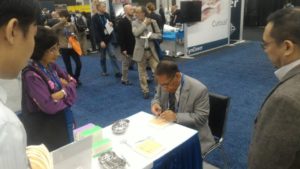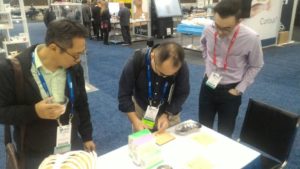
Dr. Paul Phrampus, former President of the Society for Simulation in Healthcare, practices with San Draw’s new suture simulator
If you find yourself in the emergency room needing stitches, you’re obviously going to hope that whoever performs those stitches on you knows what they’re doing. There’s not much need to worry – medical students receive incredibly thorough training, practicing all procedures on simulators multiple times before they ever have to try them on a patient. You may wonder, however, about the quality of those simulators. How close are they, in fact, to reproducing the properties of human tissue? It can be quite a different experience to practice on a training model than it is to work on an actual human being.
3D printing has improved the quality of training models so that they are about as close as a student can get to practicing on a human being. One company in particular, San Draw Medical, specializes in 3D printed training models that are highly realistic, thanks to advanced silicone 3D printing technology. Its suture simulator mimics human skin in all of its complexity, with its multiple layers and varying textures and thicknesses. Another model allows students to get a feel for giving injections to a real patient.
Now San Draw Medical has improved further on its suture training model by giving students something to suture. In traditional simulators, students have to cut the skin pad themselves with a scalpel, and it’s difficult to make a cut that actually resembles a real wound that a human would have. In addition, wounds created with the scalpel will be different every time, so it’s hard for the students to standardize their suturing technique.
 San Draw is now 3D printing skin pads with multiple wounds already part of them. There are several different types of wounds that people can suffer, and San Draw designed eight of the most common ones for the simulator with the help of surgeons. Each type has a recommended suture for the students to practice. Customers can customize their pads with any of 256 selections.
San Draw is now 3D printing skin pads with multiple wounds already part of them. There are several different types of wounds that people can suffer, and San Draw designed eight of the most common ones for the simulator with the help of surgeons. Each type has a recommended suture for the students to practice. Customers can customize their pads with any of 256 selections.
“The silicone 3D printed wounds look and feel super realistic, and I believe this product can benefit thousands of students,” Dr. John Wu, Chief Innovation Officer of CEMS, Taipei Medical University, told 3DPrint.com.
San Draw debuted the new simulator at IMSH 2018, a major medical simulation conference and trade show, which took place from January 13th to 17th in Los Angeles. According to San Draw, the company drew a great deal of attention at the show, with several medical professionals trying out the new simulator.
- Dr. Mohd Azhar Mohd Noor, National Defence University of Malaysia
- Professor Gen Ouchi, University of The Ryukyus
- Dr. John Wu, Taipei Medical University Hospital
You may not have realized there were so many different types of wounds, and that they all need different kinds of stitches, but it’s reassuring to think that now medical students can practice specific sutures for those specific wounds, rather than just stitching up a cut made by a scalpel. As medical training simulators get more complex and realistic, medical care gets better, and fewer errors are made. That’s comforting to a patient who has a nasty cut – it’s now more likely that the doctor stitching them up, no matter how new at his or her job, has done exactly this before.
Discuss this and other 3D printing topics at 3DPrintBoard.com or share your thoughts below.
[Images provided by San Draw Medical]
Subscribe to Our Email Newsletter
Stay up-to-date on all the latest news from the 3D printing industry and receive information and offers from third party vendors.
Print Services
Upload your 3D Models and get them printed quickly and efficiently.
You May Also Like
The Market and Industry Potential of Multi-Material 3D and 4D Printing in Additive Electronics
Additive manufacturing leverages computer-based software to create components for products by depositing either dielectric or conductive materials, layer by layer, into different geometric shapes. Since its birth in the 1980s,...
3DPOD 262: Bio-inspired Design for AM with Dhruv Bhate, Arizona State University
Dhruv Bhate is an associate professor at Arizona State University. There, he looks at structures, materials, and design. Previously, he worked at PADT as well as in the semiconductor and...
3DPOD 261: Tooling and Cooling for AM with Jason Murphy, NXC MFG
Jason Murphy´s NXC MFG (Next Chapter Manufacturing) is not a generalist service; instead, the company specializes in making tooling. Using LPBF and binder jet, the company produces some of the...
3DPOD 260: John Hart on VulcanForms, MIT, Desktop Metal and More
John Hart is a Professor at MIT; he´s also the director of the Laboratory for Manufacturing and Productivity as well as the director of the Center for Advanced Production Technologies....



































